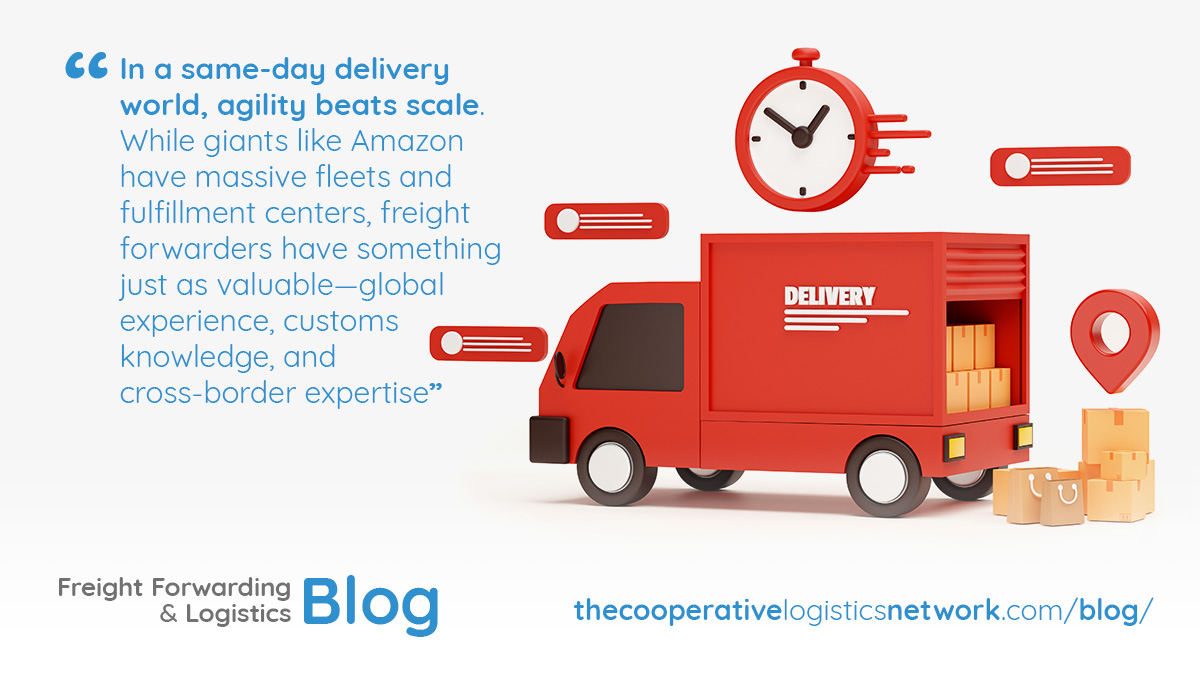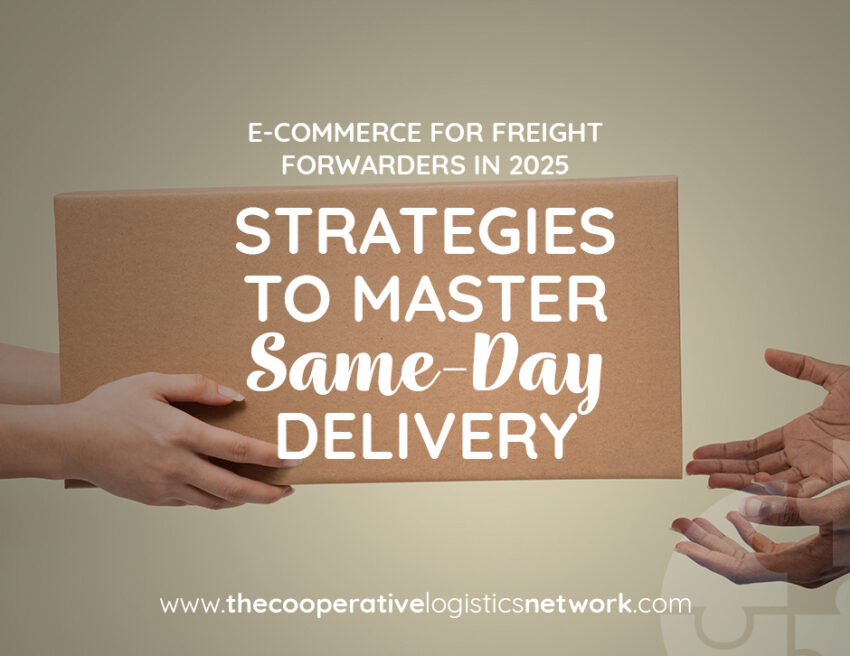Same-day delivery used to be a luxury—now it’s fast becoming the norm. As consumer expectations rise and e-commerce giants battle for speed supremacy, logistics providers everywhere are under pressure to adapt. But while large-scale couriers and fulfillment giants may have the infrastructure to move mountains overnight, what does this all mean for freight forwarders?
In 2025, the world of e-commerce for freight forwarders is shifting dramatically. Traditional shipping schedules are being replaced with real-time demands. The phrase “delivery in 3–5 business days” is starting to sound like a relic of a different era. Freight forwarders—especially small and mid-sized operators—must now compete in a world where customers expect goods to arrive just hours after clicking “buy.”
So, can freight forwarders keep up with the blistering pace of same-day delivery? Let’s explore the evolution of the trend, the challenges it presents, and the opportunities it unlocks for forwarders ready to innovate.

The Acceleration of Customer Expectations
Amazon, Alibaba, Flipkart, and JD.com have all set the standard for fast and frictionless delivery. And their influence has trickled down. Whether it’s a smartphone from Shenzhen or organic skincare from Peru, buyers expect goods to be in motion within minutes of payment confirmation.
The same-day delivery model is driven by:
-
The rise of urban fulfillment centers
-
Advanced route optimization technologies
-
Strategic partnerships between retailers and local couriers
-
Consumer behavior shifts, especially in metropolitan markets
These trends are converging to make speed a selling point, not just a convenience. And in this race for relevance, forwarders must be more than intermediaries—they need to be enablers of near-instant delivery.
What Same-Day Delivery Means for Freight Forwarders
Same-day delivery doesn’t mean the same thing everywhere. In domestic markets, it may involve hyperlocal last-mile carriers, while cross-border fulfillment relies on pre-positioned inventory and advanced coordination.
For traditional freight forwarders, this shift means:
-
Shorter planning windows: The old playbook of multi-day lead times and predictable consolidation schedules is shrinking.
-
Closer integration with retailers and platforms: Forwarders now need seamless API connectivity with e-commerce platforms, warehouses, and carriers.
-
More flexible warehousing and fulfillment: Static warehouses are being replaced by dynamic micro-fulfillment centers.
In short, to thrive in this environment, forwarders need to rethink their service offerings and evolve beyond port-to-port solutions.
E-commerce for Freight Forwarders: The Real Game Changer
The real disruption isn’t just in delivery times—it’s in how logistics integrates with e-commerce. For freight forwarders, this means offering services that start before the shipment and end after delivery. Visibility, technology, and customer experience are now as crucial as route optimization.
E-commerce for freight forwarders involves:
-
Inventory visibility across the supply chain
-
End-to-end tracking from factory to doorstep
-
Integration with shopping platforms like Shopify, Amazon, and Magento
-
Returns management and reverse logistics
-
Providing digital tools for small sellers to compete globally
Without digital transformation, forwarders risk being left out of this new loop. Online retailers expect plug-and-play solutions, not emails and spreadsheets.
Challenges Freight Forwarders Face in the Same-Day Landscape
1. Limited Control Over the Last Mile
Most freight forwarders are experts in middle-mile logistics—moving cargo from port to warehouse or between countries. But same-day delivery hinges heavily on the last mile, which is fragmented, expensive, and unpredictable. Outsourcing it can mean losing visibility and brand value.
2. Cost Pressures
Speed comes at a price. Offering same-day delivery often requires warehousing goods close to end customers and paying for faster transportation methods. For smaller forwarders working on thin margins, absorbing or passing on these costs can be tricky.
3. Tech Gaps
Many freight forwarders still operate on outdated TMS or legacy ERP systems. Same-day delivery, however, requires:
-
Real-time inventory tracking
-
Route planning algorithms
-
Customer notifications
-
Exception management tools
Without these tools, offering or even supporting same-day models becomes a challenge.
4. Regulatory Complexities
Same-day delivery for cross-border shipments introduces customs clearance challenges. Ensuring documents are correct, duties are paid in advance, and packages are pre-cleared is crucial. Few forwarders have robust systems for high-frequency, small-parcel customs workflows.
How Forwarders Can Adapt and Compete
The rise of same-day delivery doesn’t have to spell doom for freight forwarders. In fact, it opens the door to transformation and new revenue streams.
1. Embrace Urban Logistics Partnerships
Collaborating with local courier networks and last-mile tech startups can bridge the gap in delivery speed. This allows forwarders to offer end-to-end solutions without building everything in-house.
2. Build Micro-Hubs and Dark Stores
Setting up urban fulfillment hubs in key locations allows for quicker last-mile dispatch. These hubs don’t need to be large—they just need to be strategically located and technologically equipped.
3. Offer Same-Day Options for Select Goods
Not every product needs same-day delivery. Freight forwarders can segment their offerings by product type, urgency, and region. Focusing on high-margin or perishable goods can make same-day profitable without overextending.
4. Leverage Predictive Analytics
AI and data tools can help predict when and where demand spikes may occur, allowing for pre-positioning of goods closer to end-users—reducing the need for ultra-fast transport.
5. Digitize Everything
If there’s one non-negotiable takeaway, it’s this: Digital transformation is key. Every point of the freight forwarding journey must be visible, responsive, and automated where possible. A modern e-commerce for freight forwarders strategy is built on technology, not manual coordination.
The Bigger Picture: Competing Through Agility, Not Size
In a same-day delivery world, agility beats scale. While giants like Amazon have massive fleets and fulfillment centers, freight forwarders have something just as valuable—global experience, customs knowledge, and cross-border expertise.
By using that expertise and forming the right tech and delivery partnerships, forwarders can build hybrid models. They can own the international leg, integrate with regional couriers, and provide seamless service for brands and shippers who want to deliver fast without the burden of managing logistics themselves.
Final Thoughts: Speed Is Here to Stay
Same-day delivery isn’t just a trend—it’s the new benchmark. For freight forwarders, this shift requires more than just faster trucks. It demands a full transformation of strategy, services, and mindset.
E-commerce for freight forwarders in 2025 will be defined by how well you can plug into the new delivery ecosystems, digitize operations, and offer speed without compromising on reliability or profitability.


